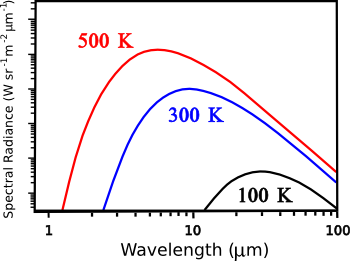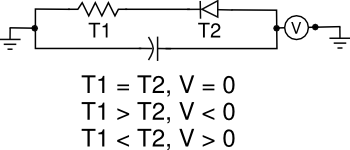Energy-Harvesting the Earth's Heat
March 10, 2014
As if
adding insult to injury, we've needed to scrape a lot of
frost from our
automobile windshields on the few snow-free mornings we've had this season in
Northern New Jersey. When finally finished scraping and on the road, we still needed to be wary of "
black ice." Black ice is
transparent, not black, but it gets its name from this transparency's allowing the usually black
pavement to be seen instead of the ice.
Our
ancestors would have blamed all this on
Boreas, the
god of the
north wind. Boreas was sometimes depicted as a old man with shaggy hair, a beard and cloak, holding a
conch shell. Substitute a
slide rule for the conch shell, and that's the image of some of the old
scientists I've known.

(Statue of Boreas at the Palace of the Four Winds, Warsaw, Poland, via Wikimedia Commons.)
We now know that
radiative cooling is to blame. The
black-body radiation of heat is responsible for
cool nights under clear skies and consequent formation of
overnight ice.
Such cooling is a consequence of the
temperature difference between the
Earth's surface and
outer space, which is ideally at the temperature of
cosmic microwave background radiation of about 3
kelvin. In most cases,
clouds act as thermal isolation, so the driving force is the smaller temperature difference between Earth and clouds.
Altostratus clouds, which appear several
miles above ground, have temperatures as low as about -30°
C, while the somewhat higher
cirrostratus clouds might be as cold as -50°C.
Thermodynamics tells us that we can extract
work from a temperature difference. An object placed between the Earth and the sky would see a difference in thermal radiation between its top and bottom sides. If we're smart enough, we might be able to
harvest energy from this effect.
The devil is in the details, and the detail here is that things near
room temperature radiate at the
longer infrared wavelengths (see figure). Inexpensive
silicon will convert radiation to
electricity only when the wavelength is less than about 1.1
micrometer (μm). More expensive
germanium will work up to 1.7 μm, while the more exotic
semiconductor,
indium gallium arsenide, will work up to 2.6 μm. Above those wavelengths, things get more difficult.

Blackbody spectral radiance curves near room temperature.
(Illustration by the author using Inkscape.)
Harvesting the Earth's heat energy in this fashion would be important for at least one reason - It's
solar energy harvesting that happens at night. With proper design, it might be possible to create a
photovoltaic device that functions both during the day, and at night. Scientists at
Harvard University's School of Engineering and Applied Sciences decided to analyze this energy-harvesting idea, and they've
published their findings in a current issue of the
Proceedings of the National Academy of Sciences.[1-2]
The interesting aspect of their approach is that they're using the
emission of thermal radiation, not its absorption, to produce electricity. Says
principal investigator,
Federico Capasso,
"It's not at all obvious, at first, how you would generate DC power by emitting infrared light in free space toward the cold... To generate power by emitting, not by absorbing light, that's weird. It makes sense physically once you think about it, but it's highly counterintuitive. We're talking about the use of physics at the nanoscale for a completely new application."[2]
A device for generating electricity from the temperature differential between the Earth and the night sky would be possible without any new
technology by using
thermoelectric panels. One side of a thermoelectric, coated with a high
albedo material, would attain a lower temperature than the other side by radiating heat to the sky. Because of the
inefficiency of thermoelectrics, this approach would only generate a few
watts per
square meter, which is just enough to power a
cellphone.[2]
A better option is the emissive energy harvester, which acts like a
photovoltaic cell. The Harvard device, as shown in the
schematic, uses a
resistor as the emissive (or absorptive) device forming one
thermal reservoir, and a
diode as the other thermal reservoir. The resistor can, in fact, be a nanoscale
antenna designed to efficiently radiate the long wavelength light.[2] Capasso says that the essential idea was invented in 1968 by
J.B. Gunn, known in microwave research as the inventor of the
Gunn diode.[3] An energy-harvesting panel would be composed of a large array of such nanoscale circuits.[2]

Mid-infrared energy harvesting circuit. There would be many of these on each collection panel.
(Illustration by the author using Inkscape.)
Such a device is only now enabled by advances in
nanofabrication technology and new materials, such as
graphene. One problem in this
circuit, as in others containing diodes, is that diodes don't function well at low
voltages. The Harvard team is looking at alternative diode components, such as
tunnel diodes and
ballistic diodes. There's the further requirement that the diodes must switch as fast as the
optical signals, about 3 x 10
13 hertz.[2]
Other members of the research team are lead author of the paper and Harvard
postdoc,
Steven J. Byrnes, and Romain Blanchard. The research was supported in part by
King Abdullah University of Science and Technology.[2]
References:
- Steven J. Byrnes, Romain Blanchard and Federico Capasso, "Harvesting renewable energy from Earth's mid-infrared emissions," Proc. Natl. Acad. Sci., Early Edition (published ahead of print, March 3, 2014).
- Caroline Perry, "Infrared: A new renewable energy source?" Harvard University School of Engineering and Applied Sciences Press Release, March 3, 2014.
- J.B. Gunn, "Microwave oscillations of current in III–V semiconductors," Solid State Communications, vol. 1. no. 4 (September, 1963), pp. 88-91.
Permanent Link to this article
Linked Keywords: Adding insult to injury; frost; automobile; windshield; Northern New Jersey; black ice; transparency; transparent; road surface; pavement; ancestor; Boreas; Greek mythology; god; north wind; conch; shell; slide rule; scientist; radiative cooling; black-body; radiation; radiative cooling; cool nights under clear skies; overnight ice; Palace of the Four Winds; Warsaw, Poland; Wikimedia Commons; temperature; lithosphere; Earth's surface; outer space; cosmic microwave background radiation; kelvin; cloud; altostratus; mile; celsius; C; cirrostratus; second law of thermodynamics; work; energy harvesting; The devil is in the details; room temperature; infrared wavelengths; silicon; electricity; micrometer; germanium; semiconductor; indium gallium arsenide; blackbody; spectral radiance; Inkscape; solar energy; photovoltaic; Harvard University's School of Engineering and Applied Sciences; academic publishing; PNAS; Proceedings of the National Academy of Sciences; principal investigator; Federico Capasso; direct current; DC; vacuum; free space; intuition; counterintuitive; physics; nanoscopic scale; nanoscale; technology; thermoelectric effect; thermoelectric; albedo; material; energy conversion efficiency; watt; square meter; mobile phone; cellphone; solar cell; photovoltaic cell; schematic; resistor; thermal reservoir; diode; antenna; J.B. Gunn; Gunn diode; Inkscape; nanolithography; nanofabrication technology; graphene; circuit; voltage; tunnel diode; ballistic conduction; optics; optical; hertz; postdoctoral research; postdoc; Steven J. Byrnes; King Abdullah University of Science and Technology.